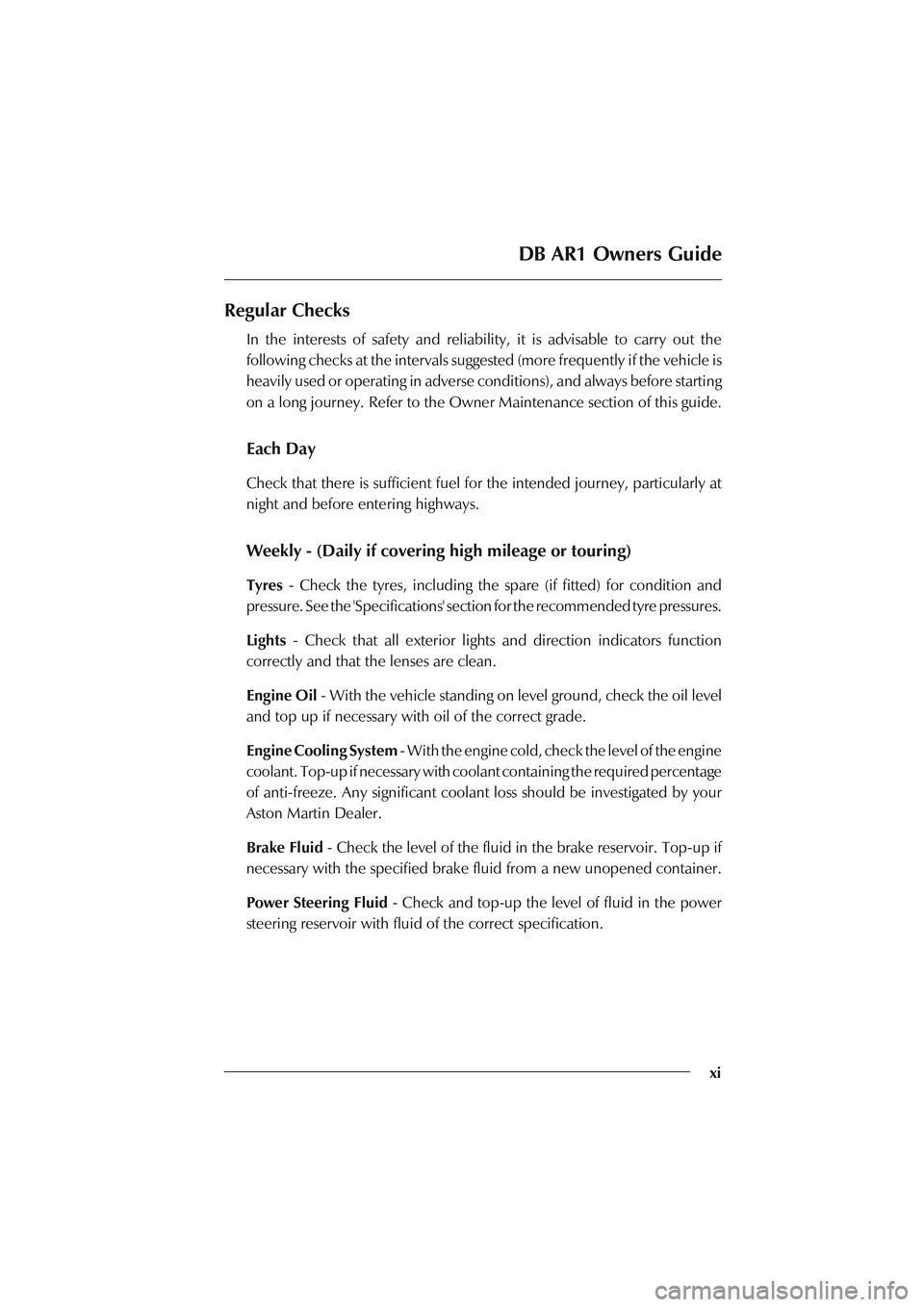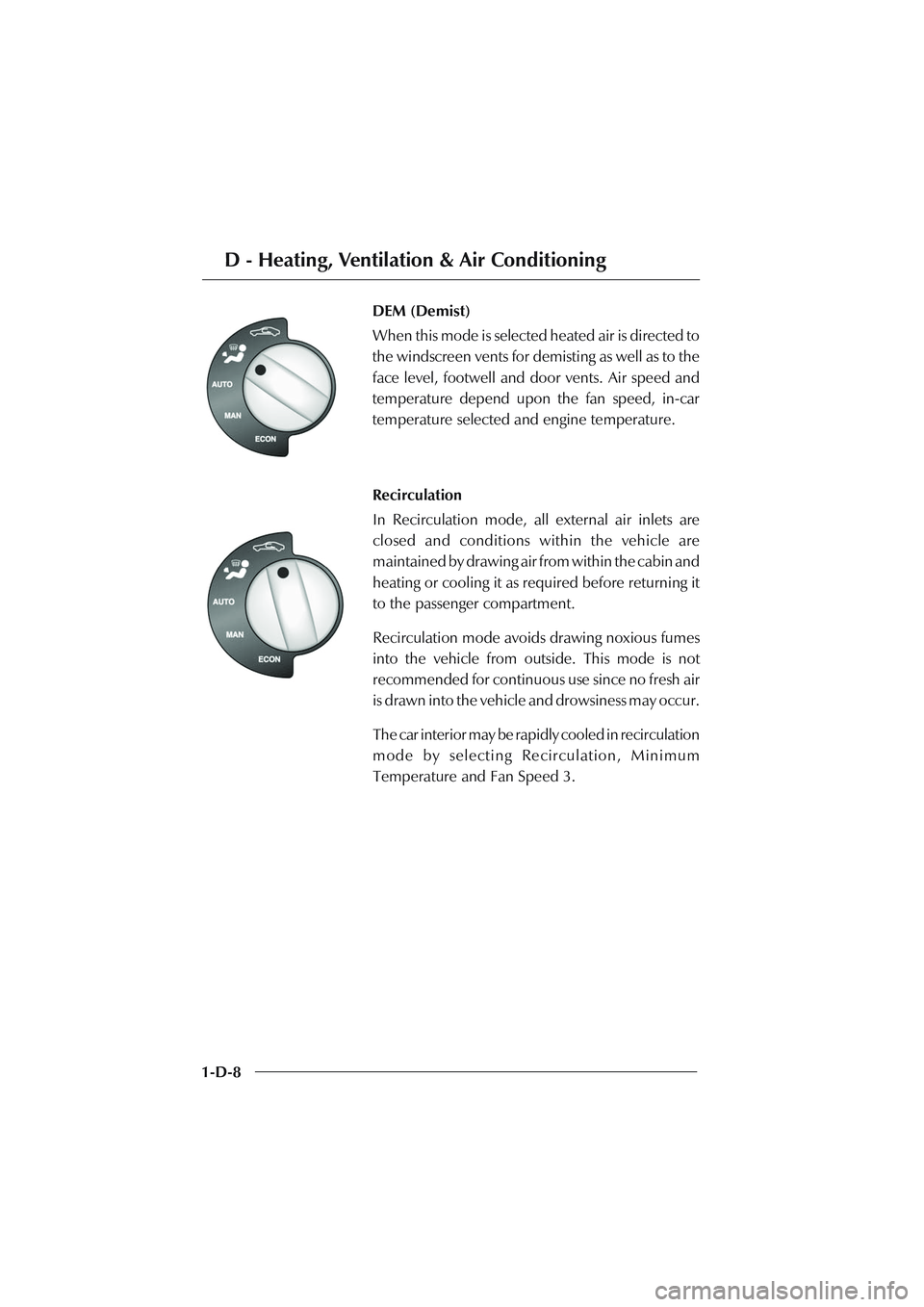cooling ASTON MARTIN DB AR1 Q 2003 Owners Guide
[x] Cancel search | Manufacturer: ASTON MARTIN, Model Year: 2003, Model line: DB AR1 Q, Model: ASTON MARTIN DB AR1 Q 2003Pages: 279, PDF Size: 3.77 MB
Page 11 of 279

xi
Regular Checks
In the interests of safety and reliability, it is advisable to carry out the
following checks at the intervals suggested (more frequently if the vehicle is
heavily used or operating in adverse conditions), and always before starting
on a long journey. Refer to the Owner Maintenance section of this guide.
Each Day
Check that there is sufficient fuel for the intended journey, particularly at
night and before entering highways.
Weekly - (Daily if covering high mileage or touring)
Tyres - Check the tyres, including the spare (if fitted) for condition and
pressure. See the 'Specifications' section for the recommended tyre pressures.
Lights - Check that all exterior lights and direction indicators function
correctly and that the lenses are clean.
Engine Oil - With the vehicle standing on level ground, check the oil level
and top up if necessary with oil of the correct grade.
Engine Cooling System - With the engine cold, check the level of the engine
coolant. Top-up if necessary with coolant containing the required percentage
of anti-freeze. Any significant coolant loss should be investigated by your
Aston Martin Dealer.
Brake Fluid - Check the level of the fluid in the brake reservoir. Top-up if
necessary with the specified brake fluid from a new unopened container.
Power Steering Fluid - Check and top-up the level of fluid in the power
steering reservoir with fluid of the correct specification.
DB AR1 Owners Guide
Page 69 of 279

C - Driving
1-C-4
Fuel Filling
The unleaded fuel tank filler neck has a restricted opening which will only
accommodate the fuel supply nozzle of unleaded fuel pumps.
To avoid fuel spillage, stop filling at the first automatic cutoff of the fuel
supply nozzle.
Catalytic Converters
The DB AR1 exhaust system contains 3-way catalytic convertors which
convert harmful exhaust gasses into less noxious substances and so reduce
environmental pollution. Catalytic converters operate at high temperatures
and continue to radiate a considerable amount of heat after turning off the
engine.
WARNINGS: Leaded fuel will cause irreparable damage to the catalytic converters.
If you do inadvertently put leaded fuel into a DB AR1, DO NOT START THE
ENGINE. DO NOT DRIVE THE CAR. Contact your Aston Martin Dealer immediately.
Do not park over dry grass, leaves or other combustible material. A significant
fire risk exists because of residual heat in the catalytic converters.
Do not drive through deep water. The rapid cooling of the catalyst may cause it
to break up. Replacement catalytic converters are expensive.
Page 91 of 279

D - Heating, Ventilation & Air Conditioning
1-D-2
The Air Conditioning System
Note: Air conditioning performance will be degraded due to the general nature
of this vehicle.
The air conditioning system is used to maintain a selected temperature level
within the passenger compartment. The system has heating, ventilation and
air conditioning functions. The system offers other functions such as
humidity control, rapid demisting and defrosting of the windscreen and
recirculation of internal air to avoid drawing unpleasant fumes into the
vehicle.
Heating/Cooling
Incoming air may be heated or cooled to a chosen temperature and then
distributed within the passenger compartment through a number of fixed
and adjustable vents. Once set, the chosen conditions will be maintained by
the computer controlled air-conditioning system.
Page 95 of 279

D - Heating, Ventilation & Air Conditioning
1-D-6Defrost (A/C Off)
In defrost mode, the system is automatically switched
to high fan speed and maximum heat with no air
conditioning. The hot air is directed to the screen and
door vents only. The door vents may be closed to
direct maximum air flow to the screen.
Right Panel (A/C Mode Switch)
The right panel contains the mode switch and temperature differential
controls.
The mode switch settings are:
Economy (A/C off)
Manual Control
Auto Control
Demist
Recirculation
ECON (Economy)
In the ECON position, the air conditioning compressor is switched off.
Incoming air can be heated if required and the fan speed can be adjusted
to increase or decrease the airflow in the vehicle. This mode puts minimum
load on the engine and gives the best fuel economy with no air conditioning
(no cooling or dehumidifying of incoming air).
Page 96 of 279

D - Heating, Ventilation & Air Conditioning
1-D-7 MAN (Manual)
In Manual mode, the air delivered from the vents
remains at the temperature set on the temperature
control regardless of the temperature inside the
passenger compartment. In this mode, incoming
air is also dehumidified and blended.
AUTO Control
This is the automatic mode of operation in which
the heating and cooling functions of the system
operate automatically, as required, to maintain
the selected in-car temperature. In this mode,
incoming air is also dehumidified and blended.
Note: If the incoming air requires little heating or cooling when in AC mode, the
centre vent will close reducing the air flow in the upper part of the passenger
compartment. If more airflow is required, the Demist function can be used to
provide the same temperature level but with increased air flow to the windscreen
vents.
Page 97 of 279

D - Heating, Ventilation & Air Conditioning
1-D-8DEM (Demist)
When this mode is selected heated air is directed to
the windscreen vents for demisting as well as to the
face level, footwell and door vents. Air speed and
temperature depend upon the fan speed, in-car
temperature selected and engine temperature.
Recirculation
In Recirculation mode, all external air inlets are
closed and conditions within the vehicle are
maintained by drawing air from within the cabin and
heating or cooling it as required before returning it
to the passenger compartment.
Recirculation mode avoids drawing noxious fumes
into the vehicle from outside. This mode is not
recommended for continuous use since no fresh air
is drawn into the vehicle and drowsiness may occur.
The car interior may be rapidly cooled in recirculation
mode by selecting Recirculation, Minimum
Temperature and Fan Speed 3.
Page 113 of 279

F - Owner Maintenance
1-F-4
Servicing Precautions
To avoid personal injury, the following safety precautions must be observed
when the bonnet is open and the engine is running or the ignition is switched
on.
WARNINGS:
Keep hands, hair, tools, items of clothing and jewellery clear of all drive belts,
pulleys and operating mechanisms. The cooling fans may operate even though
the engine is not running. The windscreen wiper mechanism is fitted with an
intermittent delay facility and may operate unexpectedly if left switched on.
Carbon monoxide is a dangerous gas and can cause unconsciousness and may be
fatal. Do not breathe exhaust gas as it contains carbon monoxide which by itself
has no colour or odour. Never start or leave the engine running in an enclosed,
unventilated area.
Avoid skin contact with all exhaust system and engine components, engine fluids
and escaping steam. They may be hot and will burn you.
Whenever possible work in the engine compartment with the engine cool, the
ignition switched off and the battery disconnected.
Do not work beneath the car with the vehicle lifting jack as the only support.
Place suitable stands under the car.
Keep children and pets clear of the car. Do not allow anyone inside the car unless
specifically working to your instructions.
Page 149 of 279

F - Owner Maintenance
1-F-40
Passenger Footwell Fusebox - Left Hand
F1 15A Accessory Terminal
F2 10A Transmission Control Module, Gearshift Interlock
Module, PRND Switch
F3 5A Headlamp Relay, Instrument Pack, Dimmer Unit
F4 10A Multi Function Unit, Air-Conditioning In-Car Sensor,
Anti-Lock Brakes Control Unit
F5 5A Traction Control Switch, Alternator Regulator, Heated
Front Screen Control
F6 10A Rear Fog Switch, RH Dip Beam
F7 30A Starter Relay
F8 10A LH Dip Beam
F9 20A LHS Seat Heater Relay, LHS Seat Module
F10 40A Heated Front Screen Controller
F11 10A RH Horn
F12 30A LH Rad Cooling Fan
F13 10A LH Horn
F14 30A RH Rad Cooling Fan
F15 30A Primary Powertrain Control Module RHS
F16 10A Multi-Function Unit, Central Locking Module, Air
Conditioning Control Panel, Alarm Sounder
F17 30A Secondary Powertrain Control Module LHS
F18 5A Interior Map Lights, Instrument Pack,
RH Rad Module
F19 10A RH Main Beam
F20 20A Window Lift Cut Out, Accessory Terminal,
Air Conditioning Clutch Relay
F21 10A Instrument Pack, LH Main Beam
F22 25A Front Fog Relay
Page 150 of 279

F - Owner Maintenance
1-F-41 Boot Fusebox
F1 10A Reverse Light Relay
F2 20A Security System & Tilt Sensors
F3 5A +12V Ignition
F4 5A Boot Switch Logic Relay, Security System Control Unit
F5 30A Accessory Terminal
F6 5A RH Fog Lamp, Powertrain Control Modules
F7 20A Fuel Pump 2, Secondary Powertrain Control Module
F8 10A HM Stop Light, LH Stop Light
F9 10A Boot Lamps, Radio Aerial Motor
F10 10A Accessory Socket
F11 20A Not Used
F12 20A Not Used
F13 10A Airbag Control Unit
F14 30A Not Used
F15 20A Fuel Pump 1, Primary Powertrain Control Module
F16 10A Rear Fog Light Relay
F17 10A Manual Gearbox Cooling Pump
F18 10A Accessory Terminal
F19 10A RH Tail, Side, Side Marker and
Number Plate Lamps
F20 20A Premium ICE Amplifier
F21 10A LH Tail, Side, Side Marker and
Number Plate Lamps
F22 20A Manual - Exhaust By-pass System
Automatic - Not Used
Page 168 of 279

F - Owner Maintenance
1-F-59 When returning the car to normal service, set the tyre pressures to normal
specification before driving on the road.
Extended Storage
For storage periods exceeding six months the following additional measures
are recommended;
Run the car until there is as small a quantity of fuel in the tank as is practical
for storage purposes.
Caution: Do Not Drain The Fuel System
Add Engine Oil to the remaining fuel in the tank to ensure a concentration
of 2% (i.e. 20ml per 1 litre of fuel) and then run the engine for not less than
ten minutes to circulate the mixture thoroughly through the entire fuel
system.
Inspect the rubber connections of the cooling system and have them
renewed if necessary.
Wash the bodywork of the car thoroughly and repair any paint
blisters or patches of rust in order to prevent any further deterioration.
Apply a suitable polish.
Clean the carpets and upholstery thoroughly. Dust them with an
anti-moth powder and store in a dry place. Treat all leather upholstery
with an appropriate leather conditioner.
If the storage building is dry leave the car windows slightly open. If
there is any tendency towards dampness close the car doors and
windows and place an anti-moisture compound such as Silica desiccant
bags in an open metal container inside the car.
Cover the car with it's fabric cover.